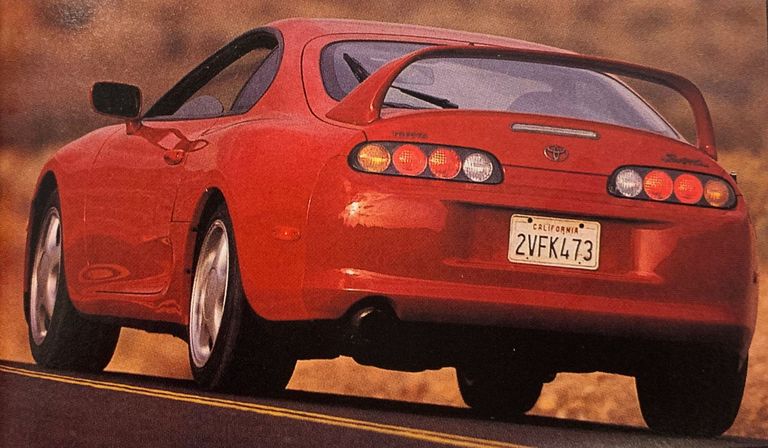why your bumpers appear off-shade from the rest of the car
Author: Andre Clemente, Founder of New Old Cars, LLC ©
About the author
Last updated: July 16, 2020
Photo Credit: David Dewhurst, Car and Driver 1993 Toyota Supra road test
Once you see it … it’s too late. There’s no going back. You’ve been scarred for life.
We wish we could skip over it, or that it simply wouldn’t bother us. Unfortunately, it’s usually the biggest eyesore on modern cars (besides orange peel, of course).
When rubber bumpers reached the end of their life during the late eighties/early nineties, manufacturers were assigned the task of paint matching a plastic bumper to a metal body. To make things difficult, they were experimenting with waterborne metallic paints for the first time, which requires an application and curing process much different than the solventborne paints they were used to. In addition, bumper design began taking on a larger role in the overall design of the car, so the color match became absolutely crucial. You can imagine the headaches and long nights faced by the factory paint departments!
While it’s still noticeable on cars today, the cars produced from 1989-2005 had it the worst, and unfortunately, this era produced some of our favorite cars of all time.
TAP IMAGES TO REVEAL TEXT
In regards to the evolution of bumpers:
“The number of base-coat colors has increased and so has the surface portion of exterior plastic, whereas separate black trims between parts and car body have almost disappeared,” says Dr. Karl-Friedrich D¨ossel of DuPont (Axalta) Coatings (Automotive Paint and Coatings, 2nd Ed). “These factors make color matching between form-integrated assembly part and car body a central issue in testing optical properties of plastic coatings today.”
Curiosity has us asking … what is the big deal? A factory paint department can cost a manufacturer upwards of $400 million, utilizing all the latest technology the world has to offer – so how can matching a plastic bumper to a metal body be that hard, even in the nineties?
NOC has decided to dig deep and find the answer. Analyzing the production process (both then and now), referencing factory training bulletins, assembly line videos, period and contemporary textbooks, as well as theories and studies conducted by the top auto finish suppliers in the world addressing this subject. We want to know exactly what was going on behind those doors.
But before we break it down, lets start with the fact that bumpers are painted separately from the metal body. A car is painted as a bare shell with no bumper cover attached. Bumper covers are painted either by another supplier at a different location or in a separate paint department in-house, known as “offline painting”:
TAP IMAGES TO REVEAL TEXT
So why are they painted separately?
Well, there are quite a few reasons, but here are the main ones: Plastic bumpers can’t handle the heat of the 300+ degree ovens used to thoroughly bake and cure a metal body. Secondly, the paint used on bumpers is different than the paint used on metal, as it needs to be flexible for “bumper duty”. In addition, the metal bodies are given a “charge” before they enter the paint booth, so that the oppositely charged paint coming out of the fancy electromagnetic sprayers stick to the surface like a magnet. Obviously a plastic bumper can’t be charged like their metal counterparts, so they cannot be painted together.
Painting two different materials at two different locations with two different application methods can introduce a wealth of color-matching problems – problems that manufacturers must overcome in order to successfully match the bumper cover to the car:
1. FLAKE ORIENTATION NEVER MATCHES BETWEEN A PLASTIC BUMPER AND METAL BODY
Part of meeting customer demands and increased competition meant transitioning from the bland color options of the 80’s into something new and enticing. While metallic paints have been around for decades, manufacturers were experimenting with this type of paint more than ever at the turn of the 90’s, producing special effect colors with large, coarse metal flakes and high flake count.
The company Axalta (formerly DuPont), one of the top coating manufacturers in the world, states: “Think of the aluminum flakes and pearls in the paint as tiny mirrors. When light shines onto a mirror’s surface, it is reflected back in the exact opposite direction. Similarly, when light shines onto the aluminum flakes in a vehicle’s finish, the flakes are reflected back in a straight line to the opposite direction.”
The issue with metallic paint jobs is that the flakes must have the same alignment between panels to look uniform. When aligned correctly, the sparkle on all panels will appear the same from all viewing angles. However, if the flakes on one panel are aligned differently than the one next to it, the two panels will appear dissimilar to each other.
It is common to think that variations between paint batches (from being painted painted at a different location) is what causes this phenomenon on production cars. However any variations are extremely small (due to the intense quality control) and won’t make much of an impact in the overall appearance. Incorrect flake alignment plays a bigger role in the lack of uniformity between panels:
TAP IMAGES TO REVEAL TEXT
2. PLASTIC REQUIRES A DIFFERENT PAINT SPRAYER
TAP IMAGES TO REVEAL TEXT
The higher momentum from the pneumatic sprayers force the flakes to “spread” and flow out differently, resulting in a sparkle that doesn’t quite match that of the metal panel next to it.
Speaking of “flow” – understand that paint flows as part of the curing process, which exposes another problem that the paint department faces:
3. PAINT CURES DIFFERENTLY ON PLASTIC, AND IT CAUSES PROBLEMS
Plastic has a lower surface tension than metal, and while manufacturers treat the plastic in ways that increase this tension, it will never match that of a metal surface. The paint will, therefore, flow differently on the bumper compared to on a metal body. This introduces headaches for the carmaker, as the different flow rate wreaks havoc on the flake alignment. As Dr. Karl-Friedrich D¨ossel of DuPont (Axalta) Coatings states: “Flake orientation is strongly influenced by rheology of the paint.” (Rheology basically refers to the flow properties of the paint).
Additionally, bumpers need a longer cure time than the rest of the body, since plastic is baked at a lower temperature. More time to cure means more time for flakes to settle and shift (from gravity). When flakes sink deeper into the paint, they reflect less light. To make matters worse, the lower temperature doesn’t play well with waterborne paint, which requires higher temperatures to cure (evaporate the water) than the solventborne paint found on older cars.
So the paint shop is tasked with matching flake orientation on two different surfaces, each with a different surface tension and different curing properties. Oh, and there’s more…
TAP IMAGE TO REVEAL TEXT
4. THE PAINT USED ON BUMPERS HAS TO BE MORE FLEXIBLE
Bumpers are designed to absorb 5mph collisions, which requires the ability to flex upon impact. This means the paint on the surface has to be flexible as well.
Most manufacturers utilize a unique, “flexible” formulation of the body color paint to address this for bumpers. In the 90’s and early 2000’s, for example, flex additives were used to make the paint permanently softer.
BYK-Gardner states “Flake orientation can also be influenced by the paint formulation,” which can include flow or flex additives. While these additives have no direct effect on the color, they can influence the time it takes for the paint to cure. It’s been established that flake orientation is heavily influenced by the curing time, so this makes body-color bumpers especially difficult to match when you consider the paint on the metal body is of a different formula (one that can cure faster).
5. THE COLOR MATCH ISN’T VERIFIED WHATSOEVER AFTER BUMPERS ARE MOUNTED
Part of the high tech paint inspection of the metal body is to compare and measure flake orientation and DOI (image clarity) consistency between the body panels. Note that this is done before the bumpers are installed. (see below)
Since the bumper covers are painted elsewhere, they are not subjected to a comparative analysis with the adjoining panel they bolt up to. They are individually inspected for imperfections once cured, and then they are sent straight to the assembly line, where things like the interior and wheels are installed.
Sure, the employees give the car a once-over under special lighting after the bumper is installed, but the paint is not checked with any expensive equipment – only the human eye and a hand wearing a special glove are used to spot defects. No further verification of color matching is done between the bumper and neighboring panels. No spectrophotometer or DOI meter is used to verify flake alignment or match the shade of the adjoining panels. Once it’s on, that’s it!
As one of the leading textbooks on the subject states: “Examination of color matching is not exclusively a matter of judgment by eye but more and more a matter of physical measurements.” (Automotive Paint and Coatings, 2nd Ed). Essentially, you need actual measurements from dedicated equipment designed to measure gloss, color impression, DOI, etc from multiple angles. (Note: this doesn’t apply to tactics utilized in the refinishing industry. The scientific measurements are needed to produce a repeatable result on the production line in a timely manner).
Here is a snapshot of what goes into inspecting the bare shell after paint (before the bumpers are installed):
TAP IMAGES TO REVEAL TEXT
Now, manufacturers could argue that bumper covers don’t require such thorough inspection after installation … the paint application process has advanced so much, and the quality control is so high, that today’s bumper covers match pretty closely “out of the box”. Plus, some car makers will occasionally conduct tests on a sample run of cars (only about 5% of cars are tested) with ultra modern equipment to ensure the paint match meets their standard.
But in the 1990’s (and even early 2000’s) this simply wasn’t the case. The color match equipment available at the time was only utilized by a few (if any) car makers, as it was either too large for the production line, too complex, too expensive, or it simply didn’t exist yet. As a result, cars were leaving the factory looking like this:
CUE THE MKIV SUPRA
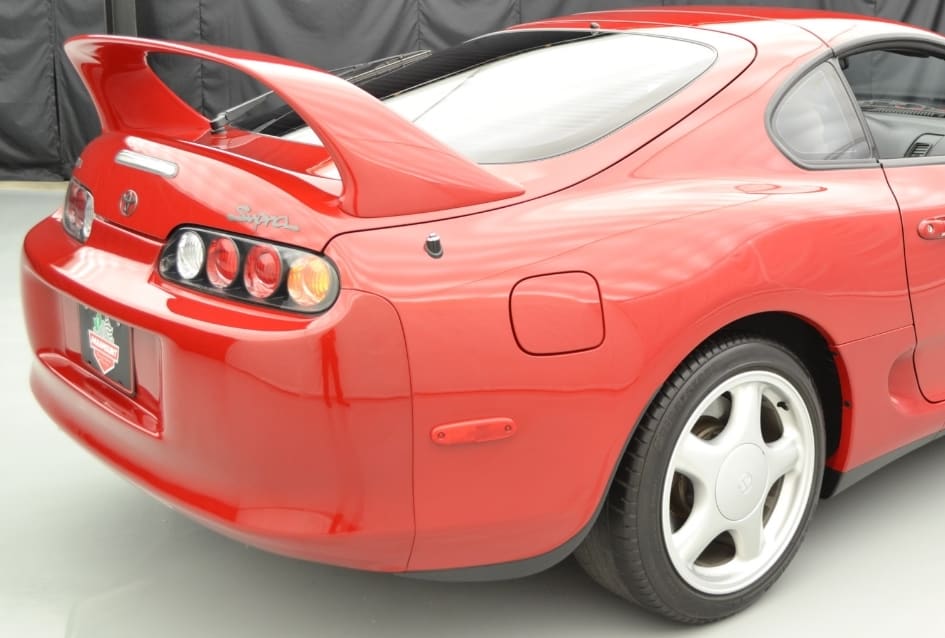
The infamous Toyota Supra with 7k original miles that sold on Bring A Trailer. Just look at that rear bumper! When released in 1993, the Supra was offered with some of Toyota’s most advanced paints at the time, including an all-new color clear coat. Vibrant special-effect and tri-coat colors were available, some with large flakes and high flake count that gave off quite a sparkle. A lot of “experimenting” was going on at Toyota’s paint department, but not a lot of “perfecting” – the relatively new task of closely matching a painted bumper to a car body on the assembly line was easier said than done (car makers were still transitioning from the unpainted bumpers of the 80’s). Adding to the headaches was the fact that there was no ultra-advanced, multi-angle paint evaluation equipment used by companies of today – the tech simply didn’t exist yet. In the end, the only method that Toyota (and everyone else) had for confirming bumper color match was the good ‘ol human eye (by visually comparing the bumper against some color match test squares on the occasional “sample” car). This inevitably produced mixed results depending on the color, viewing angle, and lighting. But while this problem was shared throughout the industry, some car companies produced better results despite facing the same hurdles.
And in Toyota’s defense, not all of their cars were famous for such a paint mismatch between bumper and body – so what made this phenomenon such an eyesore on the Supra?
One could assume the fault lies in the paint quality control of the bumper supplier at the time, but that particular supplier provided Toyota with bumpers to more than just the Supra. Plus, other Toyota and Lexus models wore exactly the same paint colors (given different names, but same paint code) and it wasn’t nearly as obvious as the Supra. So … what gives?
Blame the design of the rear end.
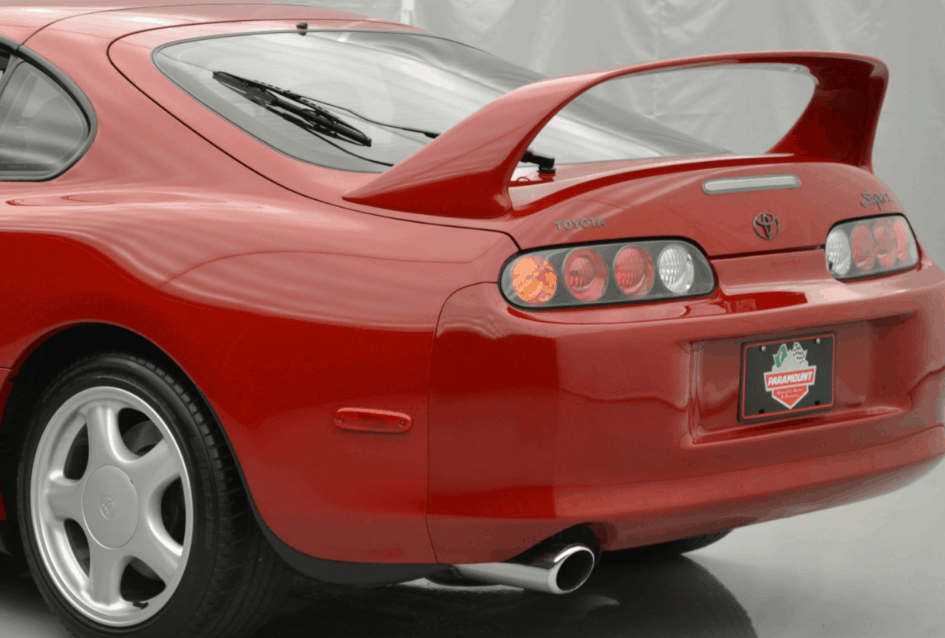
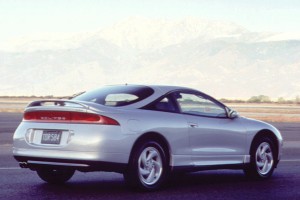
As beautifully shaped as it is, the sheer size of the bumper dominates the rear of the car. The bumper is almost as tall as the edge of the quarter panel! This is at a time when competitors (think 300ZX, 3000GT, Porsche 964, etc) had tiny rear bumpers in comparison. A paint mismatch won’t stand out with a tiny bumper as much as it does on the Supra. And while the 2nd gen Mitsubishi Eclipse had the biggest rear bumper of them all, very little of the bumper touches the quarter panel. This is an important detail, and it leads us to the second issue with the Supra’s design.
You see, the rear bumper doesn’t wrap all the way around the rear from wheel to wheel like other cars – it instead stops far short (same with it’s cousin, the Lexus SC). This means the Supra’s enormous bumper is completely engulfed by quarter panels of a slightly contrasting shade, resulting in a major eyesore. In comparison, bumper covers that fully wrap around the rear will only touch the quarter panel along the wheel arch area. The smaller connection between the two parts makes any contrast much less noticeable to the eye.
Further proof of this theory can be found on the C4 Corvette:
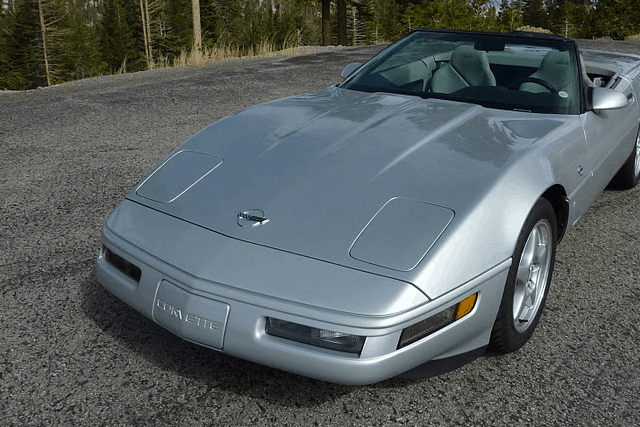
A Collector’s Edition C4 with 10k original miles and original paint that I took on consignment years ago. Chevrolet’s issues derived from the fact that the body was constructed of flexible sheet-molded compound (SMC), while the bumpers were of Reinforced Reaction Injection Molded (RRIM) panels. These composites most likely had different surface tensions, which meant the paint flowed differently on each when curing. As a result, the metal flakes on the bumper settled into a distinct alignment, resulting in the lightness flop you see here.
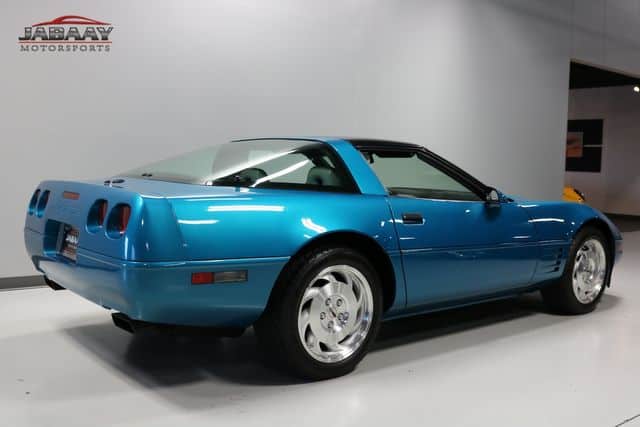
Here’s one that was for sale by Jabaay Motorsports in rare Bright Aqua Metallic with under 4k original miles. The C4 Corvette, like the Supra, had a bumper that dominated entire rear of the car, which made an improper color match all the more obvious. Chevrolet has since acknowledged this, and by the time the C6 was in production, the color match between bumper and body was almost flawless.
BUT THE BUMPER ON MY CAR MATCHES PERFECTLY?!
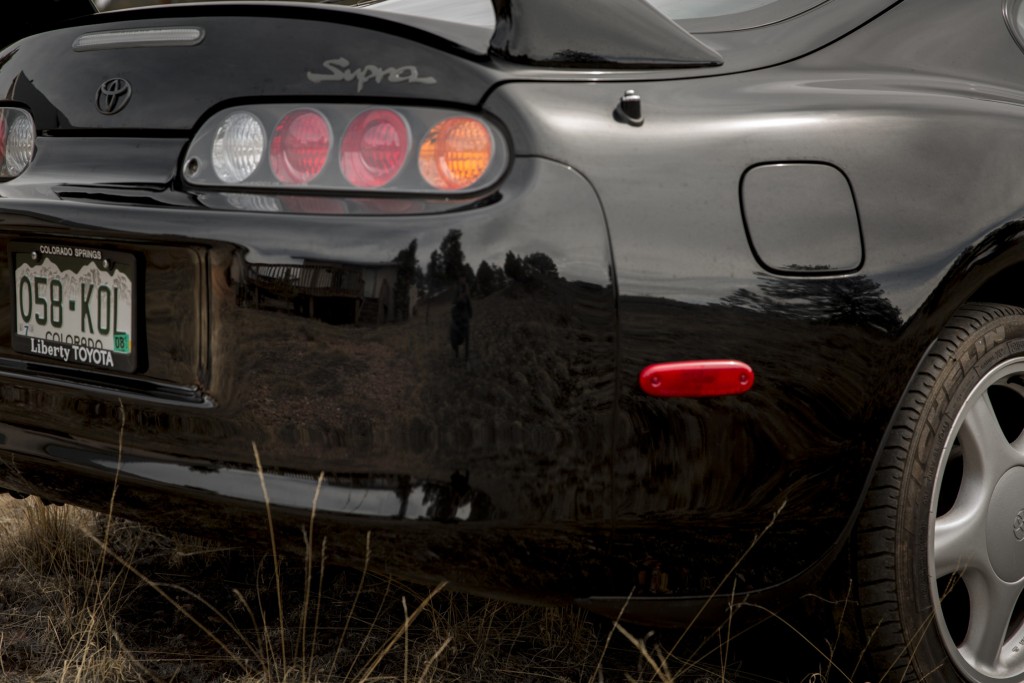
While there isn’t a list out there ranking exactly which colors are hardest to color match from worst to easiest, some colors are notorious for being more difficult than others. Metallic Silver is one of them, so is white. and certain shades of red can be difficult. The intensity of the color also plays a role.
“Additionally, the geometric designs of some cars make it hard to achieve color harmony, as its perception also depends on the smoothness of the geometric passage between car body and assembly part.” – (Automotive Paints and Coatings, 2nd Edition). The C4 Corvette had this problem, as it did not have a smooth transition from rear bumper to quarter panel like the C5 generation did.
And when it comes to metallic paints, it doesn’t matter how “easy” or “hard” the color is to match – if the flake orientation is off, you’ll notice a lack of uniformity. According to Axalta,“Flop variations occur with pearl and metallic colors. Solid colors do not exhibit flop”. This does not imply that solid colors are exempt from paint mismatch, however. Just look at Supra on this page – Renaissance Red is a non-metallic paint.
Also, while your car might appear to match well in the garage, it may expose itself in the sunlight. “Color change can be dependent on illumination and viewing angle.” (Automotive Paints and Coatings, 2nd Ed.) Exposed in direct sunlight, paint can hide nothing!
SUMMARY
Manufacturers aren’t stupid. They acknowledge the difference in appearance between the bumpers and metal body, but ensuring an absolutely perfect match isn’t feasible in the production process without high expense.
“In serial production, it can be seen that the high demands in color matching of assembly parts up to now, succeed only at high expenses. It seems that a further increase of the plastic with body-colored surface depends largely on the cost structure,” says Dr. Karl-Friedrich D¨ossel.
Remember, the manufacturer is capable of finding a solution for just about anything, but because they build cars for a profit, they have to cut expenses where they can. As long as the color match between body and bumper cover meet their minimum acceptable standards, they are happy with it.
Just remember – a skilled bodyman in the refinishing industry can spend hours color matching a bumper cover: spraying multiple cards, letting them dry, comparing it to the car in the sunlight, then doing it all over again if none of the cards match – eventually he will get it perfect. In comparison, Toyota produces an entire car every 12 minutes, which means they are unable to utilize such labor-intensive methods. So when you consider that a bumper cover, which is painted separately, is matched this close to the body despite all the hoops the carmaker has to jump through … the “eyesore” becomes an easier pill to swallow.
Other articles you may enjoy:
How To Inspect For Original Paint On Any Car
Those Paint Defects Most Likely Aren’t From The Factory
What A Paint Thickness Gauge Really Tells You
Orange Peel: Why Your New Car’s Paint May Look So Bad
…and more, in the Tech section!
Author:
Andre Clemente, Founder of New Old Cars, LLC ©
Article last updated: July 16, 2020
About the Author: Andre Clemente, a member of the Society of Automotive Historians (SAH), has spent over 12 years in the business of buying and selling cars – half of those years were dedicated to the classic car/sports car business. As an automotive paint fanatic, Andre has been hyper-focused on learning paint correction and inspecting automotive paintwork, working alongside veteran dealers, brokers, and a licensed Concours judge in the process. Years of real-world practice and application gave him the experience to identify inaccuracies and myths that are widely accepted when authenticating a vehicle’s paint job. Rather than keep his knowledge as a trade secret, he has decided to share the research and insider details he’s learned to help educate the collector car community on everything related to paint inspection and preservation of “new” old cars.
Additional Sources:
The top coating manufacturers in the world (BASF, Axalta, PPG, as well as paint evaluation tool suppliers like BYK) spend hundreds of thousands of dollars conducting tests, case studies, and other forms of research. This material is supplied to car makers to help educate them on why they need to invest in their tools and equipment in order to save money in the paint shop and produce a better looking product. Much of this material is available online in the form of textbooks, brochures, in-depth papers, and more. While highly technical, NOC’s silly obsession for knowledge on this topic means we dissect virtually anything we can get our hands on, pick out the interesting stuff, and highlight it in our articles. Below you’ll find some of the material used for this article:
Uniform Color and Appearance of Exterior Automotive Finishes: BYK Gardner
A Journey Into the History of Gloss Measurement – BYK
Intro to Metallic Color by BYK Gardner: Influence of flake Orientation
on total color impression
Color Matching for Metallic Coatings by Jayant Silva and Kristin J. Dana – Rutgers University
BYK Additives and Instruments: Solutions for Coatings and Plastics
Streitberger, Hans-Joachim, and Dössel, Karl-Friedrich. Automotive Paint and Coatings, 2nd Edition – Chp 9: Coatings for Plastic Parts. WILEY-VCH Verlag GmBH & Co, 2008.
BYK Gardner: Solutions for Coatings and Plastics 2010/2011
Collision Repair Information for the Toyota Dealer: Waterborne Paint Guide and Repair
Sherwin-Williams Training Bulletins: Flex Additives
Volkswagen VW Golf 7 Car Factory Production Plant [GOMMEBLOG]
BYK Gardner – In the History of Gloss Measurement
BYK Gardner Appearance Measurement Equipment
…and many more! NOC takes incredible pride in posting only the most accurate information with the help of credible sources. Now, because some links are no longer active, not all sources are posted here. These links have been removed from the source’s website for unknown reasons. However, NOC downloads and retains all sources used to stand by every statement in this article. This is done for all articles on our website, and NOC is happy to share this information with the public. Your trust is our number one priority.
